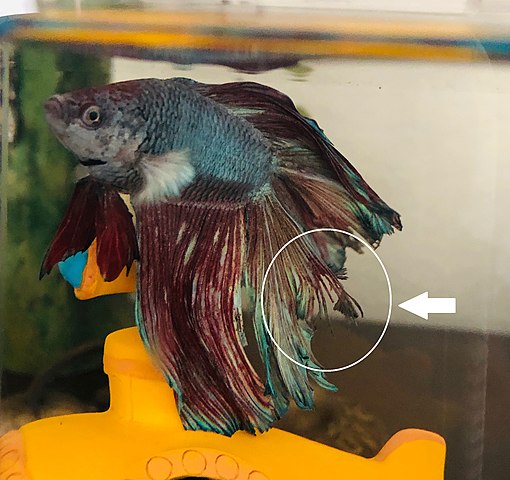This is a usual disease that leads to the decay of the tail or the fins of a fish, this is caused by bacteria that eats your fish’s fins. These illnesses are easy to treat but can lead to other serious problems – it can rot the whole fish’s body and cause death if left untreated.
Fin rot is not caused by a single type of harmful bacteria, especially waterborne bacteria.
There are many other types of bacteria that can lead to fin rot such as; fungal and pseudomonas fluorescents. Sometimes, both types of infections are seen together. Most times bacteria are harmless as long as your aquarium is cleaned regularly.
The rot of fins begin at the edge of the fins, then it destroys other tissues till it reaches the base. Once at the base, the fish is not able to regenerate worn out tissues, and tissues that are lost, the rot now can begin to invade the body of the fish; this is called advanced fin and body decay.
Fin Rot Symptoms in Aquarium Fish
Fin rot is commonly found in aquarium fish such as goldfish and betta fish. Symptoms may vary depending on how long the fish has been affected:
- In the first stage of the fin rot, the fins and / or tail begin to show a change in color, especially at the edges. Depending on the color of the fish, the color may change to white, red, or black.
- While the infection circulates, little fragments of the fin gradually die as they fall of and the edges become stunted. With time the fins of the fish get smaller and shorter as the dead flesh keeps shedding fins that are affected. An entire fin and / or tail is rotten, and infection begins to invade the body, which can lead to loss of life.
What can lead to the rot of fins?
- Rot of fins and tails in fishes are usually caused by bad water and abnormal temperatures or exposure to other potentially infectious fish. Aggressive tank mates that are larger or known for nipping, the stress from this nipping by other fishes can lead to injuries which are also common reasons for fin rot.
- Overcrowding, over-feeding, and transporting also results in stress and then rot of the fin. It is accompanied with signs like the lack of appetite, little or no activity, and settling at depth of the tank.
- Treating fin rot in your fish:
- Clean the aquarium including the gravels beneath to eliminate wastes and debris.
- Do not neglect the veterinarian, instructions, as different dosage preparations may differ from various manufacturers, which makes it very necessary for the treatment to be given at the appropriated time and proper recommendation because interrupting the treatment may lead to a recurrence of the infection.
- Monitor your fish daily to check for progress. Once the treatment is completed and is successful, it becomes easier to see the fins that were damaged heal and grow back later.
More so, it is necessary to manage the situation immediately so that there is no much harm done to the fishes. However, should the treatment not begin early, the tissues may not regenerate when the decay has reached the body of the fish, which is why it is important to start treatment early.
A couple of antibiotics have proven to be effective for the treatment of the chronic inflammation. However, the main cause should be treated so the rot does not re-occur.
How to avoid the rot of fin
The most effective way of preventing rot and other fish diseases, is good aquarium care; good water quality, maintaining adequate water temperature and regular water changes.
Avoid put too many aquatics in the tank, and be on guard for fights between the fishes and also the ones that could nip at each other. Although most fishes are calm, not all species are harmonious.
It is also advisable to monitor your fishes and check if they are compatible to prevent any fighting between them.
- Avoid over feeding, the fish eats for just three minutes two times in a day, which is the only way a fish should be fed right. Too much is an error that pollutes the water, reduces the quality and makes the fishes prone to different ailments. The time spent feeding the fish is also a perfect time to take a closer look at the behavior of your fish. Keep an eye on the daily routine for changes in the behavior, tail, fin, body, and then appetite.







